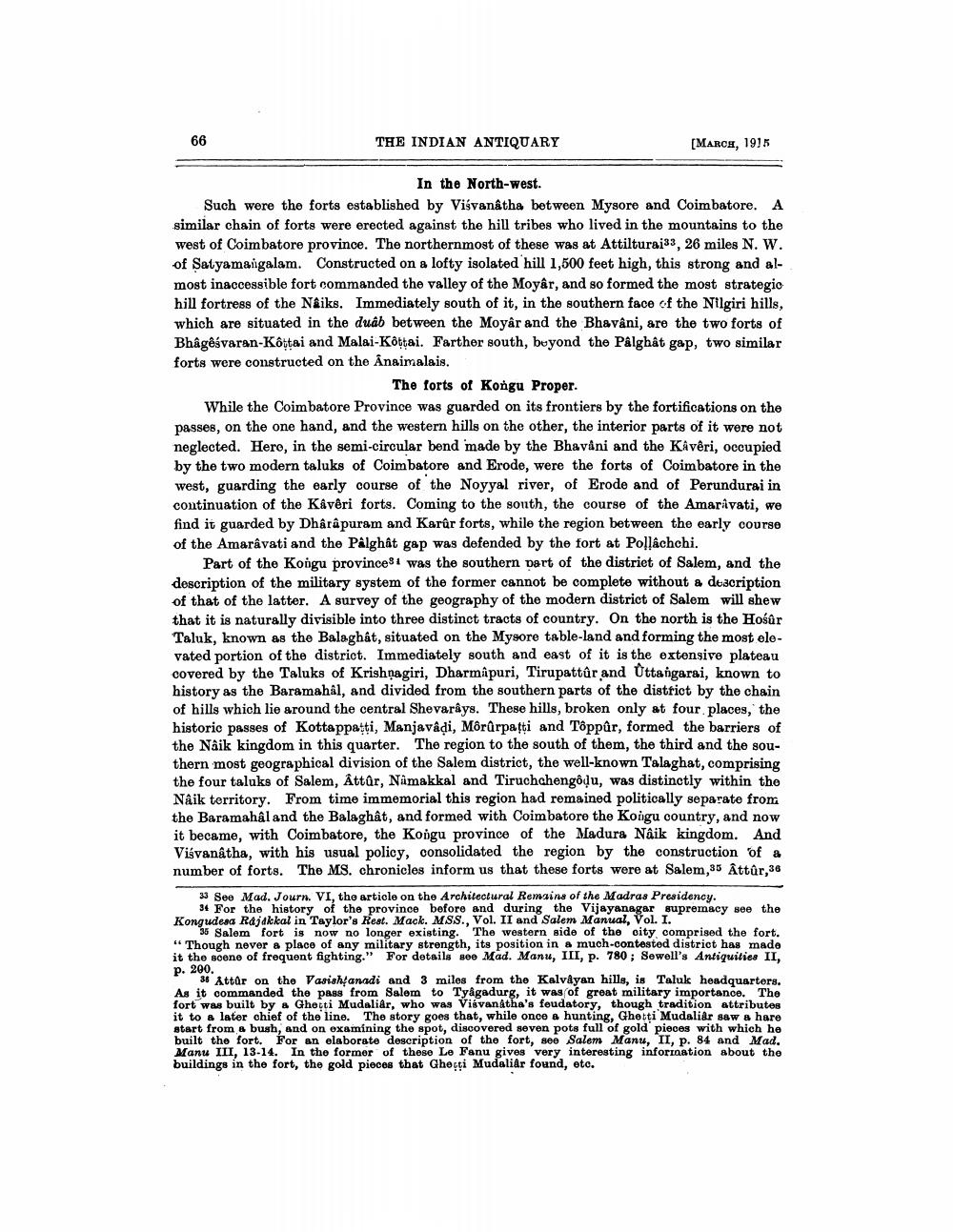________________
THE INDIAN ANTIQUARY
[MARCA, 1995
In the North-west. Such were the forts established by Visvanatha between Mysore and Coimbatore. A similar chain of forts were erected against the hill tribes who lived in the mountains to the west of Coimbatore province. The northernmost of these was at Attilturai33, 26 miles N. W. of Satyamangalam. Constructed on a lofty isolated hill 1,500 feet high, this strong and almost inaccessible fort commanded the valley of the Moyâr, and so formed the most strategic hill fortress of the Näiks. Immediately south of it, in the southern face of the Nilgiri hills, which are situated in the duab between the Moyâr and the Bhavani, are the two forts of Bhâgésvaran-Kottai and Malai-Kottai. Farther south, beyond the Palghat gap, two similar forts were constructed on the Anaimalais.
The forts of Kongu Proper. While the Coimbatore Province was guarded on its frontiers by the fortifications on the passes, on the one hand, and the western hills on the other, the interior parts of it were not neglected. Hero, in the semi-circular bend made by the Bhavani and the Kåvêri, occupied by the two modern taluks of Coimbatore and Erode, were the forts of Coimbatore in the west, guarding the early course of the Noyyal river, of Erode and of Perundurai in continuation of the Kávéri forts. Coming to the south, the course of the Amaravati, we find it guarded by Dharapuram and Karûr forts, while the region between the early course of the Amaravati and the Palghat gap was defended by the fort at Pollachchi.
Part of the Kongu provincest was the southern part of the distriet of Salem, and the description of the military system of the former cannot be complete without a description of that of the latter. A survey of the geography of the modern district of Salem will shew that it is naturally divisible into three distinct tracts of country. On the north is the Hośûr Taluk, known as the Balaghat, situated on the Mysore table-land and forming the most elevated portion of the district. Immediately south and east of it is the extensive plateau covered by the Taluks of Krishnagiri, Dharmapuri, Tirupattûr and Uttangarai, known to history as the Baramahal, and divided from the southern parts of the district by the chain of hills which lie around the central Shevarkys. These hills, broken only at four places, the historic passes of Kottappatti, Manjavadi, Môrûrpatti and Toppûr, formed the barriers of the Näik kingdom in this quarter. The region to the south of them, the third and the southern most geographical division of the Salem district, the well-known Talaghat, comprising the four taluks of Salem, Attûr, Namakkal and Tiruchchengodu, was distinctly within the Naik territory. From time immemorial this region had remained politically separate from the Baramahal and the Balaghât, and formed with Coimbatore the Koigu country, and now it became, with Coimbatore, the Kongu province of the Madura Nâik kingdom. And Visvanatha, with his usual policy, consolidated the region by the construction of a number of forts. The MS. chronicles inform us that these forts were at Salem, 35 Attûr,38
p. 200. Attar on the the pass frolliår, who
33 See Mad. Journ. VI, the article on the Architectural Remains of the Madras Presidency.
34 For the history of the province before and during the Vijayanagar supremacy see the Kongudesa Rajakkal in Taylor's Rest. Mack. MSS., Vol. II and Salem Manual, Vol. I.
36 Salem fort is now no longer existing. The western side of the oity comprised the fort. ** Though never a place of any military strength, its position in a much-contestod district has made it the scene of frequent fighting." For details see Mad. Manu, III, p. 780 ; Sewell's Antiquities II,
38 Attär on the Vasishłanadi and 3 miles from the Kalvayan hills, is Taluk headquarters, As it commanded the pass from Salem to Tyågadurg, it was of great military importance. The fort was built by a Ghoqi Mudaliar, who was Visvanatha's foudatory, though tradition attributes it to a later chief of the line. The story goes that, while once a hunting, Ghetti Mudalier saw a hare start from a bush, and on examining the spot, discovered seven pots full of gold pieces with which he built the fort. For an elaborate description of the fort, 800 Salem Manu, II, p. 84 and Mad. Manu III, 13-14. In the former of these Le Fanu gives very interesting informaation about the buildings in the fort, the gold pieces that Gheçti Mudaliar found, etc.




